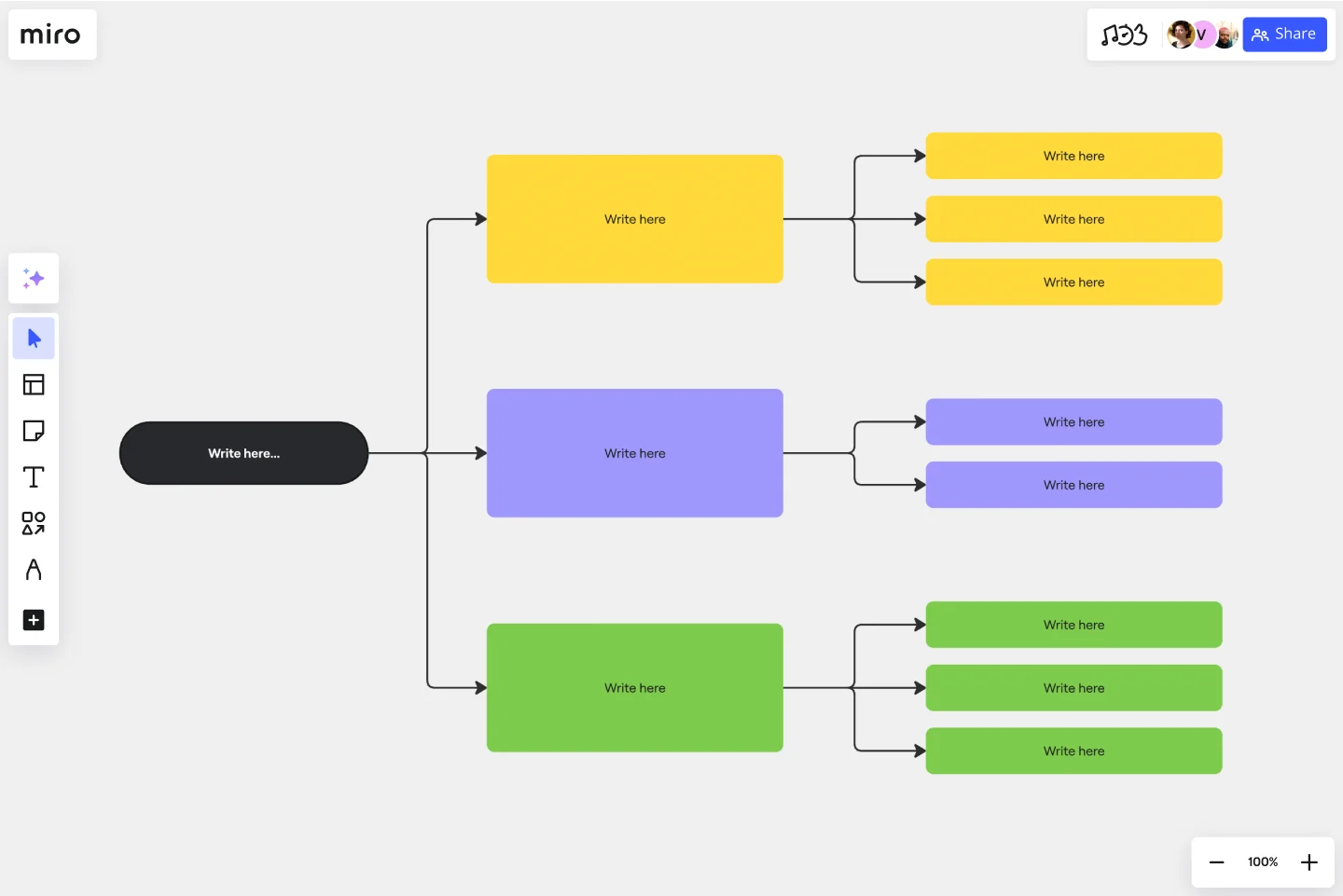Brace Map Template
Elevate your brainstorming and planning with the brace map template.
About the Brace Map Template
The brace map template helps you organize, analyze, and visualize complex ideas in a clear and structured manner. Whether you're brainstorming, planning projects, or teaching concepts, the brace map provides an adaptable workspace for your thoughts to grow.
What's the brace map template?
The brace map template is a tool that helps users analyze complex ideas by breaking them down into smaller, more manageable components. This template consists of a central concept or idea connected to supporting sub-elements through braces, forming a hierarchical structure, like a mind map. Each "brace" represents an association or relationship between the central concept and its supporting elements.
The template is divided into several key areas that allow users to organize their thoughts, including:
Central concept: This is the core idea you want to explore or analyze.
Main brace: The primary connection extends from the central concept, symbolizing the main category or theme.
Sub-braces: These extend from the main brace, representing sub-categories or supporting details.
Text boxes: Add detailed information or descriptions to each brace, providing clarity and context.
How to use the brace map template in Miro?
Edit easily: Customize the central concept, main brace, and sub-braces by simply clicking on them. Edit text, colors, and shapes effortlessly.
Expand automatically: Easily expand your brace map with a single click, allowing you to dive deeper into sub-categories and create a comprehensive visual representation.
Add context: Enhance your map by adding artifacts like images, links, or documents directly onto the Miro board, providing additional context and depth to your visualizations.
Why should you use a brace map template?
Clarity: Organize complex ideas into a structured format for enhanced clarity.
Visual hierarchy: Clearly define relationships and hierarchies between different elements.
Efficient communication: Streamline communication by presenting information in a visually digestible format.
Collaboration: Foster collaboration by creating a shared visual space for brainstorming and planning.
Dynamic exploration: Easily adapt and expand your thoughts as ideas evolve, keeping your visualizations dynamic and relevant.
Can I customize the colors and shapes of the braces in the brace map template?
Yes, click on the desired brace or element, and a menu will appear, allowing you to customize colors, shapes, and text.
How can I quickly expand the brace map with additional sub-braces?
Click on the expand button, and the brace map will dynamically grow, revealing space for additional sub-braces.
Is it possible to collaborate in real time on a brace map in Miro?
Certainly! Share your Miro board with collaborators; everyone can contribute in real time.
Can I export the brace map for external use or sharing?
Yes, Miro allows you to export your brace map in various formats, such as PDF or image files, making it easy to share your visualizations outside the platform.
Get started with this template right now.
Comprehensive Guide to BPMN
Works best for:
BPMN, Diagramming
Tame the Workflow Beast: Your Visual Guide to BPMN with Miro!
ERD Healthcare Management System Template
Works best for:
ERD
The ERD Healthcare Management System Template streamlines the process of creating and managing entity-relationship diagrams for healthcare management systems. This template helps users visualize the complex relationships between different entities such as patients, healthcare providers, medical records, and billing information. It offers a flexible and customizable framework that can be adapted to fit the specific needs of any healthcare management system, ensuring clarity and efficiency in system design and database structure.
20/80 Process Diagram - EOS Compatible
Works best for:
Diagramming
The 20/80 Process Diagram - EOS® Compatible template is a visual tool for mapping out processes and workflows aligned with the Entrepreneurial Operating System (EOS®) methodology. It provides a structured framework for identifying core processes and key activities that drive business outcomes. This template enables organizations to streamline operations, clarify roles and responsibilities, and enhance accountability. By promoting alignment with EOS® principles, the 20/80 Process Diagram empowers teams to achieve organizational excellence and drive sustainable growth.
Tree Diagram Template
Works best for:
Diagramming
The tree diagram template helps you organize and present complex information. One of its key benefits is its ability to provide unparalleled visual clarity. It enables you to simplify complicated ideas into a structured, hierarchical format, making it easier to understand and communicate. This template enhances brainstorming sessions, project planning, and decision-making processes by mapping out relationships and dependencies clearly and effortlessly. You can now say goodbye to information overload and immerse yourself in a visual journey that simplifies complexity with the tree diagram template.
BPM
Works best for:
Diagramming
The BPM (Business Process Management) template is a visual tool for modeling, analyzing, and optimizing business processes. It provides a structured framework for documenting process flows, identifying bottlenecks, and improving efficiency. This template enables organizations to streamline operations, enhance productivity, and drive business performance. By promoting process transparency and agility, the BPM template empowers teams to achieve operational excellence and deliver value to stakeholders.
CI/CD Pipeline Diagram Template
Works best for:
Diagramming, Development
The CI/CD template is a well-designed roadmap for software deployment that enables a smooth and automated flow from development to production. This strategic layout includes critical elements such as source code management, automation servers, container orchestration, staging environments, and the final deployment to production. One of the key benefits of using such a template is that it builds a robust deployment pipeline, which significantly reduces manual intervention and human error. By visualizing each step and integrating automation throughout, teams can achieve faster deployment cycles, ensuring that new features, updates, and fixes are delivered to users promptly and reliably. This enhanced pace does not compromise quality, as the template inherently supports continuous testing and quality assurance, ensuring that each update is quick but also secure and stable before it is delivered to the end user.
